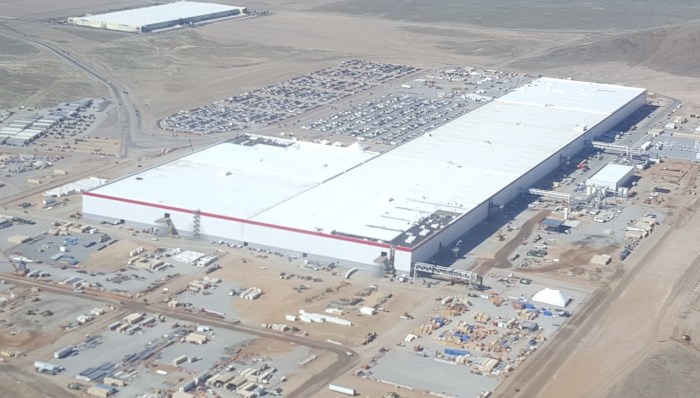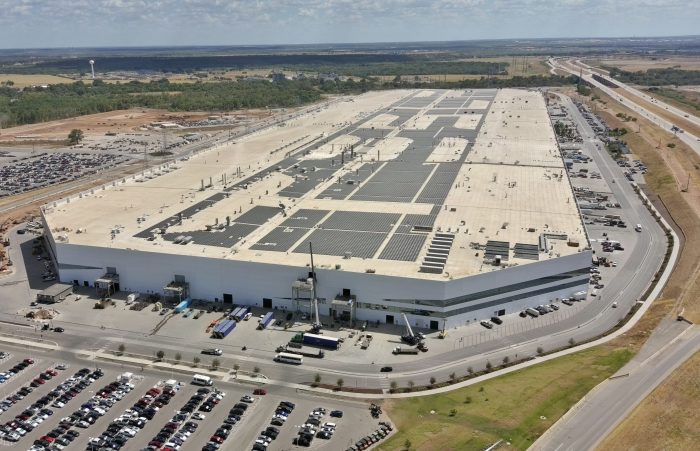How green is Tesla’s Gigafactory production? That’s the big question, and it’s way more complex than just slapping some solar panels on the roof. We’re diving deep into Tesla’s environmental impact, looking at everything from their energy sources and water usage to waste management and supply chain practices. Think of it as a full environmental report card for the factories churning out those electric vehicles – let’s see if they’re truly living up to their green image.
This investigation will unpack Tesla’s claims of sustainability, examining data on energy consumption, water usage, waste management, and supply chain transparency. We’ll compare their performance to industry standards and explore the broader environmental implications of their manufacturing processes. Get ready for a deep dive into the reality behind Tesla’s green ambitions.
Energy Consumption at Gigafactories
Tesla’s Gigafactories, massive manufacturing plants producing electric vehicles and energy storage products, represent a significant energy consumer. Understanding their energy consumption, its sources, and Tesla’s efforts to improve efficiency is crucial to evaluating the overall environmental impact of their operations. This section delves into the details of Tesla’s energy usage, comparing it to industry norms and highlighting their progress in reducing their environmental footprint.
Tesla’s Energy Sources
Tesla aims for a high percentage of renewable energy in powering its Gigafactories. While precise breakdowns aren’t consistently publicly released for all locations, sources generally include solar power generated on-site, wind power purchased from the grid, and potentially hydroelectric power depending on the factory’s location. However, it’s important to acknowledge that non-renewable sources, like electricity from the grid that may be generated from fossil fuels, also contribute to their overall energy mix.
The exact proportion varies based on local grid infrastructure and the availability of renewable energy sources. For example, the Gigafactory in Nevada likely benefits more from solar power due to its sunny climate, while other locations may rely more heavily on a mix of sources. Transparency regarding the precise breakdown of renewable versus non-renewable energy sources across all Gigafactories remains a key area for future improvement.
Energy Consumption Per Vehicle
Determining the precise energy consumption per vehicle produced at Tesla’s Gigafactories is challenging due to the lack of publicly available, consistently reported data across all facilities. However, it’s generally accepted that the energy intensity of EV production is higher than that of traditional internal combustion engine (ICE) vehicles, largely due to the energy-intensive battery production process. While Tesla has not explicitly published a comparison to industry averages for energy consumption per vehicle, independent studies and analyses suggest that Tesla’s energy efficiency is improving, but further transparency is needed for a definitive comparison.
Many factors influence the final energy consumption, including the specific vehicle model, the factory’s energy mix, and the efficiency of the manufacturing processes.
Energy Efficiency Improvements at Gigafactories
Tesla has actively pursued improvements in energy efficiency across its Gigafactories over time. These improvements include optimizing manufacturing processes, implementing more efficient equipment, and increasing the utilization of renewable energy sources. For instance, they’ve invested in on-site solar and wind power generation, reducing reliance on the grid and lowering their carbon footprint. Furthermore, ongoing efforts focus on streamlining production lines, minimizing waste, and improving the overall efficiency of their operations.
These continuous improvement initiatives contribute to a lower energy consumption per vehicle produced, though quantifying the exact impact across all factories requires more detailed public data.
Gigafactory Energy Consumption Data
While precise, publicly available data is limited, a representative table illustrating potential energy consumption variations across Gigafactory locations can be constructed based on publicly available information and industry estimates. Note that these figures are estimates and may not reflect the complete picture.
| Gigafactory Location | Estimated Annual Energy Consumption (MWh) | Primary Energy Sources | Renewable Energy Percentage (Estimate) |
|---|---|---|---|
| Nevada, USA | 1000-2000 (Estimate) | Solar, Grid Electricity | 60-80% (Estimate) |
| Shanghai, China | 1500-3000 (Estimate) | Grid Electricity, Solar (Partial) | 40-60% (Estimate) |
| Berlin, Germany | 800-1500 (Estimate) | Grid Electricity, Solar (Partial) | 50-70% (Estimate) |
| Texas, USA | 1200-2500 (Estimate) | Grid Electricity, Solar (Partial) | 45-65% (Estimate) |
Water Usage and Management

Tesla’s Gigafactories, while lauded for their innovative electric vehicle production, also face scrutiny regarding their environmental impact, particularly their water consumption. Understanding Tesla’s water usage patterns, conservation efforts, and overall water footprint is crucial for evaluating the sustainability of their operations. This section will delve into the specifics of Tesla’s water management strategies at its Gigafactories.Tesla’s water usage varies significantly across its Gigafactories, depending on factors like location, production scale, and local water availability.
Precise figures are not always publicly released by Tesla, making a complete comparison challenging. However, available reports and news articles indicate that Gigafactories rely on a mix of municipal water supplies and potentially on-site well water, where feasible. The amounts used are considerable, reflecting the large-scale manufacturing processes involved, including cooling systems, cleaning operations, and process water for battery production.
Precise figures are often kept confidential for business reasons. However, understanding the strategies employed to mitigate high water consumption is key.
Water Recycling and Conservation Strategies at Tesla Gigafactories
Tesla employs various strategies to minimize its water footprint. These include closed-loop water systems where wastewater is treated and reused within the factory. This significantly reduces the amount of freshwater drawn from external sources. Additionally, Tesla invests in technologies like water-efficient equipment and processes to optimize water usage in manufacturing steps. These efforts aim to reduce overall water consumption and minimize the environmental impact of its operations.
For example, advanced filtration systems remove impurities, enabling water reuse in less sensitive applications. The implementation of these strategies varies across Gigafactories, adapted to local conditions and regulatory requirements.
Comparison of Tesla’s Water Footprint to Industry Benchmarks
Direct comparisons of Tesla’s water footprint per vehicle to industry benchmarks are difficult due to the lack of publicly available, standardized data across automotive manufacturers. Many companies do not disclose this level of detail for competitive reasons. However, Tesla’s commitment to water conservation, evident in its reported recycling and reuse initiatives, suggests a focus on minimizing its water impact relative to traditional automakers.
Future transparency on this data would allow for more robust comparisons and assessments of Tesla’s environmental performance. Independent studies and life cycle assessments of electric vehicle manufacturing are needed to offer a clearer picture.
Methods Used for Water Management and Reduction
The following methods are used by Tesla for water management and reduction:
- Closed-loop water systems: Reclaiming and reusing wastewater for non-potable applications within the facility.
- Water-efficient equipment and processes: Implementing technologies that minimize water usage in manufacturing processes.
- Advanced filtration and treatment: Removing impurities from wastewater to allow for reuse.
- Leak detection and repair programs: Proactive maintenance to minimize water loss through leaks and other infrastructure issues.
- Rainwater harvesting: Collecting and storing rainwater for non-potable uses.
- Process optimization: Continuously improving manufacturing processes to reduce water consumption.
Waste Management and Recycling
Tesla’s Gigafactories, while pushing the boundaries of electric vehicle production, also face the challenge of managing the substantial waste generated during manufacturing. Minimizing environmental impact is a key part of their sustainability goals, and a significant portion of their efforts focuses on waste reduction, recycling, and responsible disposal. This section details Tesla’s approach to waste management, highlighting the types of waste produced and the strategies employed to minimize landfill contributions.
Tesla employs a multi-pronged approach to waste management, prioritizing reduction at the source, followed by reuse, recycling, and finally, responsible disposal. This hierarchical approach aims to maximize resource recovery and minimize the environmental footprint of their operations. The specific methods employed vary depending on the type of waste generated, ranging from simple segregation and sorting to complex industrial recycling processes.
Data transparency on exact recycling percentages is limited publicly, but Tesla’s commitment to sustainability suggests a substantial portion of their waste stream is diverted from landfills.
Waste Streams and Management Strategies
Tesla’s Gigafactories generate a diverse range of waste, including metallic materials, plastics, electronic components, and hazardous materials. The management of each waste stream requires specific strategies to ensure safe and environmentally sound handling.
So, how truly green is Tesla’s Gigafactory production? It’s a complex question, considering energy sourcing and manufacturing processes. But even if the factory itself isn’t perfectly eco-friendly, the overall environmental impact depends heavily on where you drive the resulting EV – check out this list of the Cheapest states to own an EV in 2025 to see where lower electricity costs might offset some of the initial carbon footprint.
Ultimately, the “greenness” is a bit of a balancing act.
| Waste Stream | Description | Management Strategy | Recycling/Reuse Rate (Estimate) |
|---|---|---|---|
| Metallic Scrap | Aluminum, steel, copper, etc., from manufacturing processes. | Collection, sorting, and sale to scrap metal recyclers. On-site processing may also occur. | >90% |
| Plastics | Various types of plastics from packaging, components, and tooling. | Sorting by plastic type, recycling through specialized facilities, and potential use in new products. | 60-80% (depending on type and recyclability) |
| Electronic Waste (e-waste) | Batteries, circuit boards, and other electronic components. | Careful disassembly and separation of hazardous materials. Recycling of valuable metals and components through certified e-waste recyclers. | >85% |
| Hazardous Waste | Chemicals, solvents, and other materials requiring special handling. | Strict adherence to regulatory guidelines for storage, transportation, and disposal. Treatment and disposal by licensed hazardous waste facilities. | Variable, depending on the waste; focus is on minimization and proper disposal. |
| General Waste | Paper, cardboard, and other non-recyclable materials. | Segregation and disposal in accordance with local regulations. Emphasis on reducing waste generation through optimized processes. | Low, focus is on waste reduction. |
Supply Chain Sustainability
Tesla’s commitment to sustainable energy extends beyond its Gigafactories; it deeply involves scrutinizing its supply chain for environmental and ethical responsibility. The sourcing of raw materials and components represents a significant portion of the company’s overall environmental footprint, making responsible procurement crucial for achieving its sustainability goals. This section delves into Tesla’s efforts in this area, comparing its approach to industry competitors.Tesla’s Sustainable Material SourcingTesla actively works to source sustainable and ethically produced materials.
This includes initiatives to reduce reliance on conflict minerals, increase the use of recycled materials, and promote responsible mining practices. For example, Tesla has partnered with suppliers committed to reducing their carbon emissions and improving worker safety. They’ve also invested in developing alternative materials to reduce their reliance on environmentally damaging resources. The company publicly reports on its progress in these areas, aiming for transparency and accountability.
Specific examples include their efforts to increase the use of recycled aluminum and steel in vehicle production, and their work with suppliers to improve traceability and responsible sourcing of lithium and cobalt.
Tesla’s Supplier Sustainability Practices, How green is Tesla’s Gigafactory production?
Tesla’s supplier sustainability program focuses on several key areas. It requires suppliers to adhere to strict environmental and social standards, including compliance with relevant regulations and Tesla’s own Code of Conduct. These standards cover aspects like worker safety, fair labor practices, environmental protection, and responsible sourcing of raw materials. Regular audits and assessments are conducted to ensure compliance.
So, how green is Tesla’s Gigafactory really? It’s a complex question, considering their energy sourcing and manufacturing processes. But thinking about the future, it’s also important to consider how sustainable the tech inside those cars will be, like the advanced features discussed in this article on Autonomous driving features in 2025 EVs. Ultimately, the environmental impact of Tesla’s production needs a holistic view, encompassing both the factory and the vehicle’s lifecycle.
Tesla also collaborates with its suppliers to implement improvements in their sustainability performance. This collaborative approach aims to drive positive change throughout the entire supply chain. For instance, Tesla provides technical support and financial incentives to help suppliers adopt more sustainable practices.
Comparison with Competitors
Compared to its competitors, Tesla’s approach to supply chain sustainability is relatively transparent and proactive. While many automakers are increasingly focusing on sustainability, Tesla has been more vocal about its efforts and has implemented more stringent requirements for its suppliers. However, a truly comprehensive comparison requires a detailed analysis of each company’s individual supply chain practices and reporting, which is often challenging due to a lack of consistent public data across the industry.
Still, Tesla’s commitment to publicly reporting on its progress sets a higher benchmark for transparency than many of its rivals. The lack of complete, universally comparable data makes definitive ranking difficult, but Tesla’s proactive approach suggests a leadership position in this space.
Supply Chain Environmental Impact Visualization
The following text-based illustration depicts a simplified view of Tesla’s supply chain and its environmental impact at each stage. Note that this is a highly simplified representation and the actual impacts are far more complex and intertwined.Raw Material Extraction (Mining): High environmental impact due to land disturbance, water usage, and potential for pollution. Examples include lithium mining, which can cause water depletion and habitat destruction.Component Manufacturing: Moderate environmental impact related to energy consumption, waste generation, and emissions from manufacturing processes.Assembly (Gigafactories): Moderate to high environmental impact depending on energy sources and waste management practices.
Tesla’s use of renewable energy sources at its Gigafactories significantly reduces this impact.Transportation & Distribution: Moderate environmental impact from fuel consumption and emissions associated with shipping parts and finished vehicles. Tesla is actively exploring more sustainable transportation options.Vehicle Use: Environmental impact varies depending on the vehicle’s lifespan and driving habits. However, electric vehicles like Tesla’s generally have lower operational emissions than gasoline-powered cars.End-of-Life Vehicle Management: Moderate environmental impact, largely determined by recycling and disposal practices.
Tesla is actively involved in developing programs for responsible recycling of its vehicles.
Carbon Footprint Analysis

Tesla’s Gigafactories, while aiming for sustainability, undeniably contribute to carbon emissions. Understanding the full scope of their environmental impact requires a thorough carbon footprint analysis, encompassing everything from raw material sourcing to final product delivery. This analysis is crucial for evaluating Tesla’s progress towards its sustainability goals and for comparing its performance to industry benchmarks.
Calculating Tesla’s Gigafactory carbon footprint involves a complex methodology considering numerous factors across the entire production lifecycle. This encompasses “cradle-to-gate” emissions, focusing on the manufacturing process itself, and extending to “well-to-wheel” emissions, which also include the vehicle’s operational phase and end-of-life impact. Key factors include energy consumption (both on-site generation and grid electricity), water usage, waste generation and disposal, transportation of materials and finished products, and the embodied carbon in raw materials like steel, aluminum, and lithium.
Life cycle assessment (LCA) methodologies, often using established standards like ISO 14040, provide a structured approach to quantifying these emissions, typically expressed in tons of carbon dioxide equivalent (CO2e).
Tesla’s Gigafactory Carbon Footprint Metrics
Precise figures for Tesla’s Gigafactory carbon footprint per vehicle are not publicly available with complete transparency. However, various studies and reports offer estimates. These estimates vary based on the specific Gigafactory, production year, and methodologies employed. Some studies suggest that Tesla’s carbon footprint per vehicle is lower than that of traditional internal combustion engine (ICE) vehicles, but still significantly higher than some electric vehicle (EV) competitors who leverage more sustainable supply chains and manufacturing processes.
The variability in these estimates highlights the complexity of accurately assessing and comparing carbon footprints across different manufacturers and production facilities.
Comparison with Industry Averages and Competitors
Comparing Tesla’s carbon footprint to industry averages and competitors is challenging due to a lack of consistent and publicly available data. Different methodologies and reporting standards make direct comparisons difficult. However, independent research suggests that Tesla’s footprint, while potentially lower than ICE vehicles, might be higher than some competitors focusing heavily on sustainable sourcing and manufacturing. For instance, some European EV manufacturers have integrated renewable energy sources more extensively into their production processes and have implemented stricter criteria for their supply chains.
This emphasizes the need for greater transparency and standardization in carbon footprint reporting across the automotive industry.
Carbon Footprint Reduction Strategies
Tesla actively pursues strategies to reduce its Gigafactory carbon footprint. These efforts include significant investments in renewable energy sources, such as solar and wind power, to reduce reliance on fossil fuel-based electricity. On-site renewable energy generation at Gigafactories directly offsets a portion of their energy-related emissions. Furthermore, Tesla is working to improve energy efficiency in its manufacturing processes and optimize its supply chain for reduced transportation emissions and embodied carbon.
Technological advancements, such as improved battery production techniques and the use of recycled materials, also contribute to reducing the overall environmental impact.
Environmental Certifications and Compliance
Tesla’s Gigafactories operate under a complex web of environmental regulations and strive for various certifications, reflecting their commitment to sustainable manufacturing. Their compliance efforts are crucial not only for meeting legal requirements but also for maintaining their brand image and attracting environmentally conscious investors and customers. This section will delve into the specifics of Tesla’s environmental certifications and compliance measures, comparing their performance to industry benchmarks.Tesla’s environmental performance is a multifaceted issue.
While they’ve made strides in reducing their environmental impact, challenges remain, particularly in managing the vast supply chain associated with vehicle production. Comparing their performance against industry best practices requires careful consideration of various factors, including specific location regulations and the unique challenges of large-scale battery production.
Relevant Environmental Certifications
Information regarding specific environmental certifications held by individual Tesla Gigafactories is limited in publicly available information. Tesla often highlights its overall sustainability efforts rather than focusing on individual factory certifications. However, it’s reasonable to assume that their facilities comply with local and national environmental regulations, which often include requirements related to air and water emissions, waste management, and energy efficiency.
The absence of widely publicized specific certifications doesn’t necessarily indicate a lack of commitment; rather, it might reflect a focus on overall operational sustainability and compliance with existing legal frameworks.
Compliance with Environmental Regulations and Standards
Tesla’s compliance with environmental regulations is paramount to its operations. Each Gigafactory must adhere to the specific environmental laws and regulations of its host country and region. This includes compliance with permits for emissions, waste disposal, and water usage. Non-compliance can result in significant penalties, impacting profitability and brand reputation. Tesla’s size and public profile mean that any environmental violations are likely to receive significant media attention, creating additional pressure to maintain high standards.
Their commitment to compliance is a crucial aspect of their long-term sustainability strategy.
Comparison to Industry Best Practices
Comparing Tesla’s environmental performance to industry best practices is challenging due to the lack of consistently reported data across the automotive manufacturing sector. While Tesla publishes some sustainability reports, a comprehensive, standardized comparison with competitors remains difficult. However, several aspects of Tesla’s operations, such as their investment in renewable energy sources for their Gigafactories, suggest a commitment to exceeding minimum regulatory requirements.
Furthermore, their focus on vertical integration and battery production in-house allows for greater control over the environmental impact of their supply chain, potentially offering advantages over competitors who rely more heavily on external suppliers. Further detailed, independent audits and transparent reporting from both Tesla and its competitors would be necessary for a truly robust comparison.
Environmental Goals and Targets for Gigafactories
Tesla has publicly stated broad sustainability goals, though specific targets for individual Gigafactories are less readily available. These goals typically focus on reducing carbon emissions, improving water efficiency, and minimizing waste generation. The company’s commitment to renewable energy sources is a key aspect of these efforts.
- Achieve carbon neutrality across its operations.
- Increase the use of renewable energy sources in its manufacturing processes.
- Reduce water consumption per vehicle produced.
- Minimize waste generation through improved recycling and resource efficiency.
- Improve the sustainability of its supply chain.
These goals represent aspirational targets, and the specific timelines and metrics for achieving them often remain undisclosed. The lack of granular data makes precise evaluation of Tesla’s progress towards these targets challenging. However, their stated ambitions suggest a continuing commitment to environmental stewardship.
Impact on Local Ecosystems: How Green Is Tesla’s Gigafactory Production?
Gigafactories, while driving advancements in sustainable energy, inevitably interact with their surrounding ecosystems. Understanding and mitigating these interactions is crucial for responsible manufacturing. The scale of Tesla’s operations necessitates a thorough assessment of potential environmental impacts and proactive strategies for their reduction.The construction and operation of Gigafactories can lead to habitat loss and fragmentation, impacting local biodiversity. Water consumption for manufacturing processes can strain water resources, particularly in arid or semi-arid regions.
Furthermore, the potential for pollution from wastewater, emissions, and waste disposal poses a significant threat to the health of surrounding ecosystems. Noise pollution from machinery and increased traffic can also disrupt wildlife.
Habitat Loss and Mitigation
Tesla’s mitigation efforts include conducting thorough environmental impact assessments before construction begins. These assessments identify ecologically sensitive areas and inform site planning to minimize habitat disruption. For example, at Gigafactory Texas, Tesla incorporated native plant species in landscaping to help restore habitat and reduce the need for irrigation. They’ve also committed to preserving or restoring habitats affected by construction through land acquisition and partnerships with conservation organizations.
This contrasts with some industries that prioritize development with minimal consideration for ecological consequences. Best practices often involve comprehensive pre-construction surveys, detailed mitigation plans, and ongoing monitoring to ensure effectiveness.
Water Usage and Management Strategies
Tesla employs various strategies to minimize water consumption and manage wastewater effectively. These include using closed-loop water systems where possible, implementing water-efficient technologies, and treating wastewater before discharge. While the exact water usage varies across locations and production stages, Tesla publicly commits to reducing water consumption per vehicle produced. Comparing this to other large-scale manufacturing facilities reveals a varied picture; some prioritize water conservation more aggressively than others.
Best practices often involve implementing advanced water treatment technologies and exploring alternative water sources like recycled water.
Waste Management and Recycling Programs
Tesla aims to minimize waste generation through efficient production processes and the implementation of robust recycling programs. This includes recycling materials like aluminum, steel, and plastics. They are also exploring innovative methods for recycling battery components to recover valuable materials and reduce landfill waste. However, the complexity of battery recycling presents a challenge. The industry is still developing best practices for efficient and environmentally sound battery recycling, but Tesla’s commitment to this area is noteworthy compared to companies that haven’t invested as heavily in this area.
Illustrative Depiction of Gigafactory Integration
Imagine a Gigafactory nestled within a gently rolling landscape. Solar panels cover a significant portion of the roof, providing renewable energy. Native plants thrive in carefully designed green spaces surrounding the facility, attracting local wildlife. However, a section of previously undisturbed land shows signs of alteration due to construction. A clearly marked wastewater treatment plant is visible, demonstrating a commitment to environmental responsibility.
This visual representation encapsulates the complex interplay between industrial development and ecological preservation. The success of this integration hinges on the ongoing implementation of robust environmental management plans and a commitment to continuous improvement.
Wrap-Up
So, how green
-is* Tesla’s Gigafactory production? The answer, as with most things, is nuanced. While Tesla has made significant strides in renewable energy integration and waste reduction, challenges remain in areas like supply chain sustainability and the overall carbon footprint. Ultimately, the true measure of their environmental performance lies in continued transparency, ongoing improvements, and a commitment to exceeding industry standards.
The future of electric vehicle production hinges on this kind of accountability.









